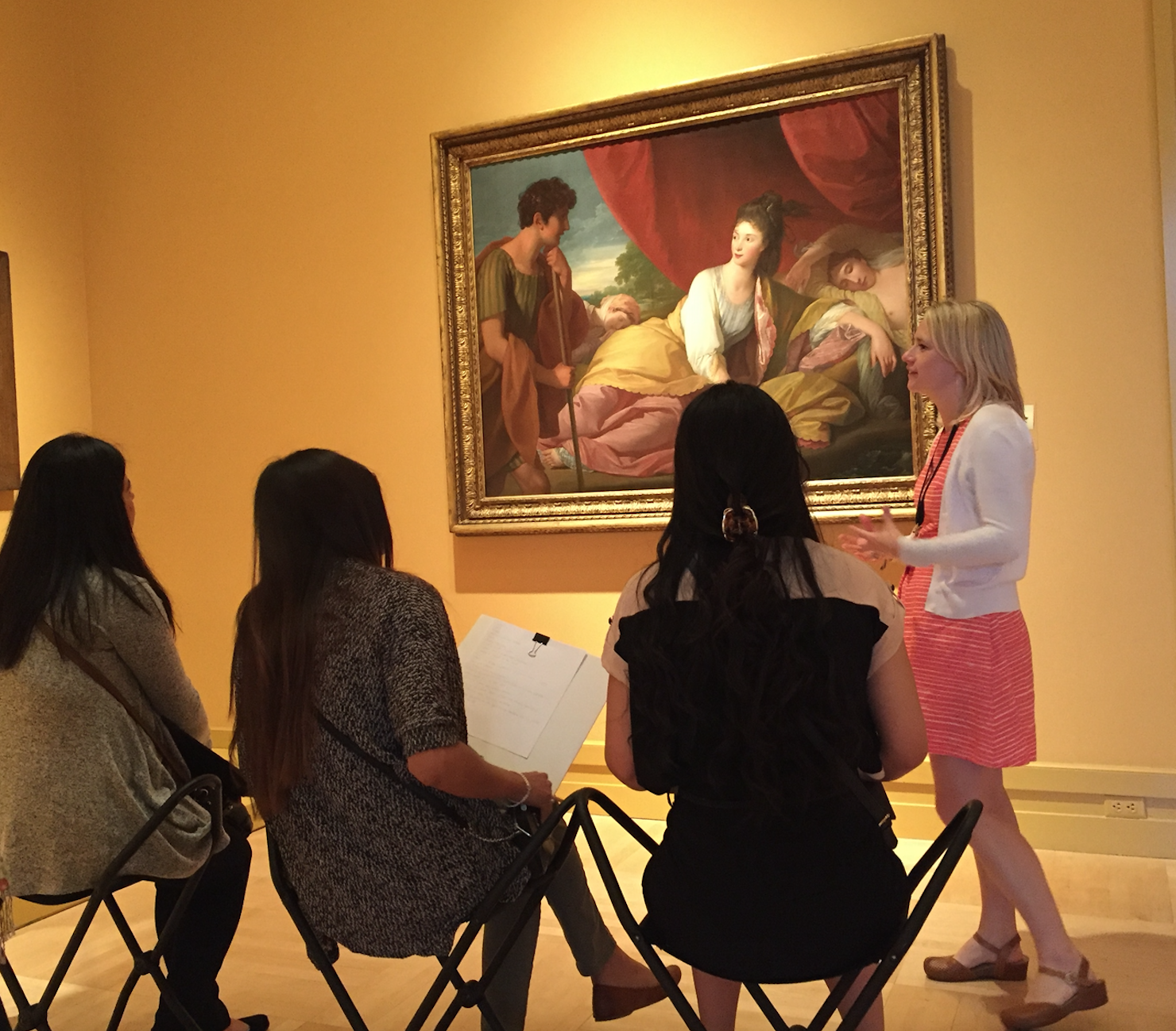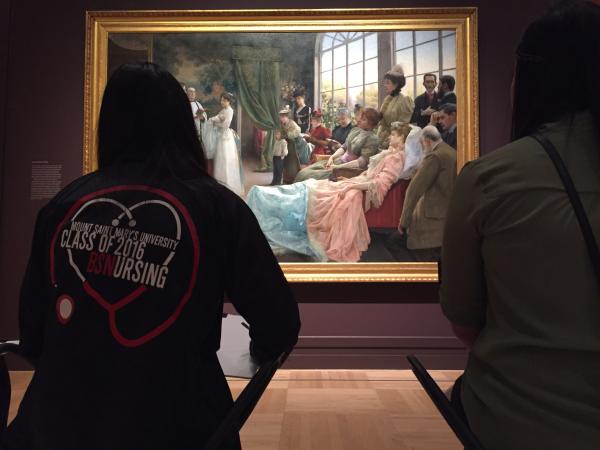It’s a Thursday afternoon when the seniors from Mount St. Mary’s undergraduate nursing program find their way to the third floor of the Art of the Americas building. They’re on campus not to look at the art, but to see it.
This is the second installment of a partnership between Mount Saint Mary’s University and LACMA's Education and Public Programs department that brings nursing students to campus to exercise their skills of observation. Looking Is Not Seeing, a program designed at Yale as a partnership between Yale School of Nursing and the Yale Center for British Art in 2008, has spread to other nursing programs—the intent is to help students understand how to draw details out of what they see in order to help them develop deeper observation skills to better help their patients. When assistant professor of nursing Sarah Shealy approached the department about working with Mount St. Mary's nursing program, LACMA's educators were eager to partner since this approach complements the department's conversation-based gallery teaching philosophy.
The students are brought to the American art gallery, teamed up in groups of four with museum educators and asked to examine the art. They splinter off toward five different paintings, setting their stools down and merely observing for five minutes. Just looking, saying nothing, letting their eyes scan and absorb the painting.
Students sit before Julius L. Stewart’s The Baptism (1892). The wall text has been covered with yellow sticky notes; the students’ observations are based on contextless looking alone. After the observation period is up, each LACMA educator asks the students to give a “visual inventory” of the work, purely to describe what they see, to give the most obvious answer without reservation. The students struggle with this stage, trying to keep themselves from veering toward interpretation.
“It’s so hard to be objective and not subjective!” one of the students says. “The focus is on the man and woman—” She stops herself, laughing. “On the two figures, while one figure is holding a smaller figure.”
“That’s hard, right?” the educator says.

Once the interpretation phase starts, the students fall into a better groove. They slowly start to understand the work and get into the details. They’re less nervous about their observations and interpretations. They talk about the space of the painting, the figures, and the relationship between figures. Their answers grow longer, more descriptive, and they begin to bring in their own experiences to the work, bolder with their declarations.
“I feel like the ceremony is taking a long time,” another student says. “It seems that the figures are all deep in thought. Or bored.”
“You brought up a word with many different meanings,” the educator says, “‘ceremony.’ What makes you think of ceremony?”
“This is from my own Catholic background,” the student says. “The child is dressed in white, indicative of a christening. And the focus is there, everyone’s paying attention to what’s going on.”
Their observations and interpretations wander across the painting until every detail has been picked out.
“The more time you spend with it, the more you notice,” the educator says. Even when the timer beeps and the next group comes through, the four students want to keep going, keep engaging, gesticulating at the painting and talking with each other.
Downstairs in the Brown Auditorium, the students congregate to discuss images of diseases and pathology, using the same methods they used with the paintings, first observing, then citing what they see and translating that into a diagnosis.
This proves difficult at first as well, and the students jump to the irregularities of the photographs, the pathology. Sarah Shealy interrupts them: “Do a complete visual inventory in the same way you did with the art upstairs. When we greet our patients, they want to be seen for who they are, not just the pathology that brought them to the hospital.”
By the end of the session, the students have gained a new perspective of slow looking and observing that turns into seeing. Seeing the whole picture, seeing the details, and merely observing before inferring.
“So how is this different from looking at the art?” Angela Taylor, assistant professor of nursing, asks. “It’s not too different. This will be very helpful in your documentation. You want to be descriptive when you do your documentation.”
After the presentation, Sarah and Angela discuss the importance of bringing the students to LACMA, engaging with observation in a medium perhaps outside of their comfort zone. “Coming to the museum is such an unusual event for the students. Many of them may never have been to a museum. Just being here changes their mindset in a way that makes it possible for us to create a shift,” Sarah explains after the presentation. “There’s always more to see. Our patients are not just their disease processes, and there are often more questions than there are answers.”
Angela adds, “It’s so important to observe—when you walk into a patient’s room and there’s all this decoration from the grandchildren, whether it’s finger art or family pictures, it really gives you a bit of an understanding about what’s holding that patient up when they’re experiencing a critical challenge. And I think that many nurses are doing it and not thinking about the fact that they’re doing it.” Taking the students out of their normal context of the hospital or the classroom helps them identify these processes they’re already exercising, and to realize that the distance between art and science is not so great.
“Nursing is described as an art and a science,” Sarah says. “The main takeaway is to keep being curious and to ask more questions. We're always hoping that our students will not only be good at the hand skills we teach but that they will also be excellent critical thinkers and observers.”



